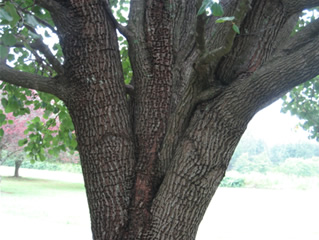Story by Rawson Services Editor / September 14, 2016

LAUREL OAKS
As far as landscape trees go, the Laurel Oak (Quercus hemisphaerica) is one of the very best for the Lowcountry. This native oak is semi-evergreen (briefly losing most of its leaves in late winter) and grows to a mature height of 40-60 feet. Laurel Oak is a rapid grower that thrives in well-draining soils.
Because it is smaller than Live Oaks and Willow Oaks, this tree has become very popular as a street tree in Charleston and in other cities along the Coastal Plain. This tree will thrive in sandy soils with low fertility. In naturalized areas of the Lowcountry, Laurel Oaks are commonly found growing in sand hills and near stream banks.
PHYTOPHTHORA BASAL CANKER
Until recently, it was thought that this tree had no major pest problems. But two years ago, a Laurel Oak disease was identified on a mature tree that died in Marion Square in Charleston. The city parks director noted that this tree was the “biggest, most magnificent tree in the park.” Laurel Oaks on John’s Island were also dying because of this disease.
Experts from Clemson University determined that this disease is caused by Phytophthora cinnamomi, a fungal pathogen.
This disease, commonly called Phytophthora Basal Canker of Oaks is characterized by “bleeding” cankers on the bottom 5-6 feet of a tree’s trunk. These cankers ooze clear or dark-stained sap that runs down the bark of the tree.
As these cankers expand, they can girdle the root collars and stems of an infected tree. The subsequent damage caused to the vascular system prevents water from reaching the leaves. As a result, trees begin to lose vigor and show symptoms of dieback. Depending on the natural resistance of the tree and environmental factors, this disease can be deadly to Laurel Oaks.
Recently, I was called to a look at a tree on James Island that went from seemingly healthy to completely dead in just two weeks. There were oozing cankers on the lower portion of the trunk. Also, all of the leaves had turned brown and were still attached to the branches. Microscopic and lab analyses indicated that the tree had been killed byPhytophthora cinnamomi and the tree was promptly taken down.
HOW TO MANAGE THIS DISEASE
In order to effectively treat for this disease, it must be done early. Laurel Oaks with visible cankers and branch dieback will not respond to fungicide treatments and should be removed.
If there are other Laurel Oaks growing nearby, it is recommended that they are treated with a fungicide to ensure that they do not become infected. Rawson Services, Inc. has the equipment and training necessary to apply the proper fungicides to the bark and soil.
Dead Laurel Oak infected with Phytophthora cinnamomi. Notice that the leaves have turned brown and are still attached to the tree.
Tree care articles by Rawson Services’ partner www.scouthort.com
The best tree service and the nicest people in Charleston.
Great service! Randy and the team called ahead to schedule, showed up right on time and did an amazing job. Thanks Rawson!
Task was to cut down and remove huge six foot diameter live oak that had split to the roots and half the tree had hit the ground. Randy and his crew finished most of the job on the first day and cleaned up the remainder the next day. Unbelievably professional and competent crew with top-notch equipment. I recommend his service without qualification.
The Rawson crew is professional, quick and clean. We had them remove four large diseased oaks that were threatening structures on our property. They arrived on time and got right to work on the intricate project.
I had a variety of tree pruning that needed to be done surrounding my home and next to my driveway. Randy and his crew were prompt, courteous and performed expert work around the property. They cleaned up nicely and the entire service was A+. Serious pros.
You should only use a tree company with current, valid general liability and workers compensation insurance.
Learn MoreRawson's crew is trained, uniformed, focused and courteous at all times. We use state-of-the-art equipment and focus on safety on every job.
Our Services
Locally owned & operated by certified arborist.